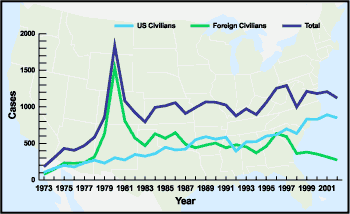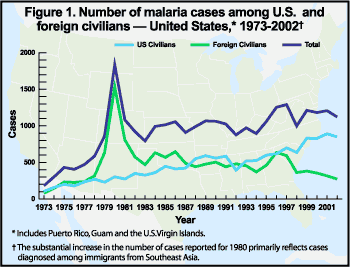 |
| Malaria
Home > |
 |
Latest United States Malaria Disease Surveillance Report-An Argument For Continuing Vigilance
|
 |
|
| Latest
United States Malaria Disease Surveillance Report-
An Argument
For Continuing Vigilance
Travelers implicated
in most cases, but malaria-carrying mosquitoes
can still transmit the disease within the United
States
|
|
| The
above chart illustrates the number of cases of malaria
reported in the US for the time period between 1973
and 2002. |
 |
CDC released recently its Malaria
Surveillance Summary for 2002. Domestic
malaria surveillance helps CDC provide recommendations to keep
travelers healthy and can identify episodes of malaria transmission
in the United States.
CDC received reports of 1,337 cases of malaria, with eight
deaths, that occurred in 2002 in the United States. All but five cases
were in persons who had traveled to a malaria-endemic area.
Prevention in Travelers
Malaria can be
a fatal disease for travelers. But it can be prevented by taking one
of the recommended chemoprophylaxis regimens appropriate for the region
of travel, and by using personal protection measures to prevent mosquito
bites.
The surveillance summary showed that only 20.9% of U.S.
civilians who acquired malaria abroad had taken CDC-recommended malaria
chemoprophylaxis. Most of these patients also reported non-compliance
with the antimalarial drug regimen. The importance of taking correct
precautions and chemoprophylaxis is underscored in the eight fatal cases
of malaria.
The surveillance summary also showed that of the cases
of malaria in U.S. civilians, almost half were diagnosed in immigrants
living in the United States who had returned to their country of origin
to visit friends and relatives. This group of travelers and their health-care
providers need to be made more aware of the importance of chemoprophylaxis
and other protective measures.
Travelers can obtain recommendations from CDC concerning
malaria prevention by calling 1-877-FYI-TRIP or by accessing CDC’s
Web sites on Traveler’s Health and
on Malaria.
Early Diagnosis And Treatment
Malaria infections can be fatal if not diagnosed and treated
promptly. Any person who has been to a malarious area and who develops
fever or influenza-like symptoms within the year after travel should
seek medical care immediately and report their travel history to their
health-care provider.
Health-care providers should elicit a travel history from
all patients who present with symptoms consistent with malaria. Clinicians
seeking assistance with the diagnosis or treatment of patients with suspected
or confirmed malaria should call the CDC Malaria Hot Line at 770-488-7788
during regular business hours, or the CDC Emergency Operations Center
at 770-488-7100 during evenings, weekends and holidays. The CDC
malaria Web site provides additional information on diagnosis and
treatment of malaria.
Malaria In Non-Travelers
Five persons
acquired malaria in 2002 without a history of travel to a malarious
area. Epidemiologic investigations identified a mode of acquisition in
four cases. One case was acquired probably through blood transfusion,
one case was due to congenital (mother-to-fetus) transmission, and two
cases were thought to represent an outbreak of locally acquired mosquito-transmitted
malaria.
Even though malaria has been eradicated from the United
States since 1951, U.S. residents remain at risk, especially when traveling
in malaria-endemic countries. Anopheles mosquitoes that are
capable of transmitting malaria are found in the United States, and constant
surveillance is required to prevent reintroduction of malaria in this
country.
Page last modified : May
7, 2004
Content source: Division of Parasitic Diseases
National Center for Zoonotic, Vector-Borne, and Enteric Diseases (ZVED)
|




